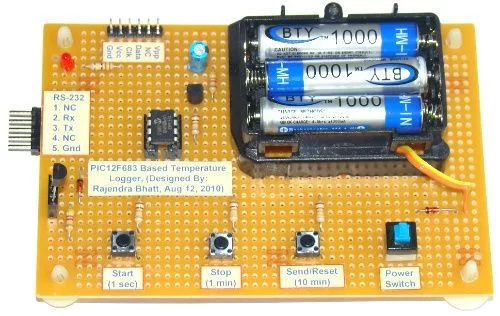Contents
hide
Introduction
There are varieties of digital temperature logger projects available online based on different microcontrollers. The one I am going to talk about is based on a Microchip’s 8-pin microcontroller, PIC12F683. It reads temperature values from a DS1820 digital sensor and stores in its internal EEPROM. PIC12F683 has 256 bytes of internal EEPROM and we are going to store the temperature values in 8-bit format. This means only the eight most significant bits of temperature data from DS1820 will be read and as such the temperature resolution will be of 1 degree C.
My temperature logger has following features:
- Reads temperature from a DS1820 sensor and stores in the internal EEPROM locations.
- Can store up to 254 temperature values. EEPROM location 0 is used to store the sampling interval, and location 1 is used to store the number of records.
- Three sampling interval options: 1 sec, 1 min, and 10 min. This can be selected during powering up.
- Start and Stop buttons for control operations.
- The recorded temperature values can be sent to PC through a serial port. A separate Send button is available to initiate data transfer.
- A LED to indicate various ongoing operations.
- Reset button to clear all previous records.
Circuit Design
PIC12F683 has 6 I/O pins, out of which one (GP3, pin 4) is I/P only pin. Here is how we are going to assign the port pins.
The six I/O pins of PIC12F683 are assigned as follows:
1. GP0 (Pin 7, I/P): This pin will be used to read the temperature value from DS1820 sensor.
2. GP1 (Pin 6, O/P): This will be used for serial data transfer to a PC.
3. GP2 (Pin 5, O/P): LED output pin.
4. GP3 (Pin 4, I/P): Send (tactile switch)
5. GP4 (Pin 3, I/P): Stop (tactile switch)
6. GP5 (Pin 2, I/P): Start (tactile switch)
For more detail: Simplest Temperature Data Logger using PIC12F683


